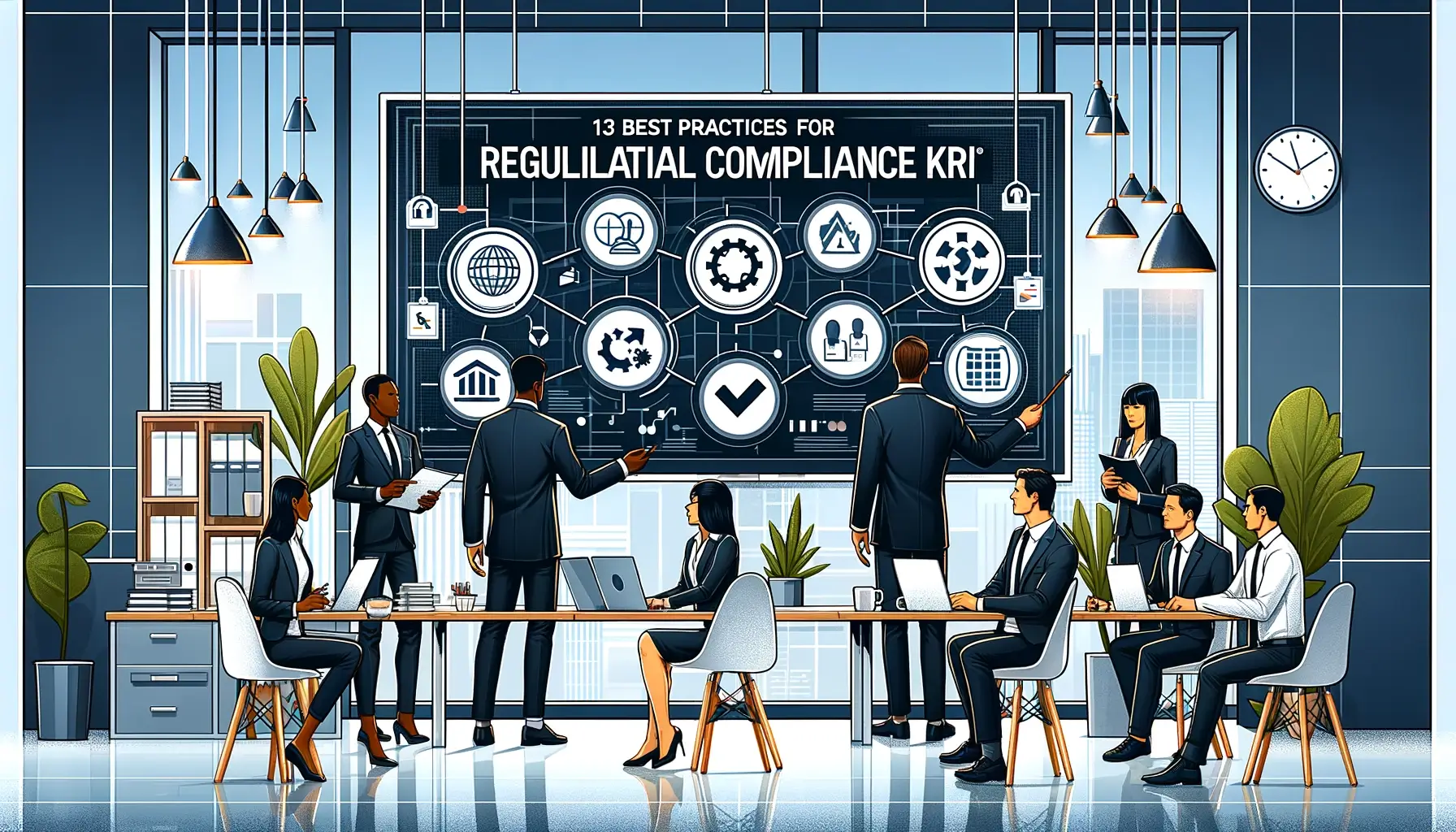In regulatory compliance, organizations must comply with a set of rules and regulations to ensure ethical and legal practices. To achieve this, implementing key risk indicators (KRIs) is crucial.
As organizations navigate through complex regulations across various industries, Key Risk Indicators (KRIs) have emerged as vital tools in this endeavor.
In our latest blog post, “13 Best Practices for Regulatory Compliance KRI,” we delve into the most effective strategies to enhance your regulatory compliance framework.
From identifying the most pertinent KRIs to integrating them seamlessly into your existing risk management processes, this article offers a comprehensive guide for businesses aiming to bolster their compliance posture.
This article explores the 13 best practices for regulatory compliance KRIs, providing valuable insights on developing business unit plans for business continuity and disaster recovery.
Businesses can navigate regulatory compliance and safeguard operations by following these recommendations.

Definition of Regulatory Compliance
To effectively implement regulatory compliance Key Risk Indicators (KRI), it is essential first to understand the need for them.
Regulatory compliance refers to the adherence of an organization to laws, regulations, and guidelines set by regulatory bodies governing its industry.
Understanding the Need for KRI
Regulatory compliance, as it pertains to Key Risk Indicators (KRI), is a critical aspect that organizations must comprehend for effective risk management.
In today’s rapidly changing business landscape, organizations face many risks related to time, security, processes, decisions, procedures, customers, and regulatory compliance.
Failure to comply with regulations can result in severe consequences, including legal penalties, financial losses, and reputational damage.
Key Risk Indicators (KRI) play a crucial role in helping organizations identify and monitor potential risks associated with regulatory compliance.
These indicators provide valuable insights into the effectiveness of compliance measures and enable organizations to take proactive steps to mitigate risks.
Organizations can identify non-compliance areas by monitoring KRIs, allowing timely corrective actions.
Understanding the need for KRI is essential as it helps organizations maintain compliance, protect their reputation, and ensure the long-term success of their business.
Organizations can use KRIs to proactively manage risks and maintain compliance.
13 Best Practices for Regulatory Compliance KRI
When it comes to implementing best practices for regulatory compliance KRI, there are several key points to consider.
First, it is crucial to identify the Key Risk Indicators (KRIs) that are relevant to your organization and its regulatory requirements.
Second, monitoring risks in real time allows for proactive risk management and timely intervention.
Third, developing a risk profile and analyzing exposure over time provides valuable insights into the effectiveness of compliance measures.
Additionally, establishing risk categories and utilizing risk management tools can help track, analyze, and mitigate risks efficiently.
1. Identify the Key Risk Indicators (KRIs)
A crucial step in ensuring regulatory compliance is the identification of key risk indicators (KRIs). KRIs are measurements used to assess and monitor potential risks that may affect an organization’s ability to meet regulatory requirements.
Proactively identifying and tracking risk indicators allows businesses to take corrective action when necessary.
To effectively identify KRIs, organizations should consider their specific risk profile and regulatory risk. This involves evaluating various factors such as financial risks, third-party relationships, and security policies.
Additionally, utilizing risk management tools can help in identifying and monitoring KRIs.
To illustrate the importance of identifying KRIs, here is a table showcasing common KRIs and their associated risks:
| KRI | Associated Risk |
|---|---|
| High number of compliance violations | Non-compliance with regulatory requirements |
| Increase in customer complaints | Poor customer satisfaction and potential reputation damage |
| Frequent security breaches | Data breaches and potential loss of sensitive information |
| Decline in financial performance | Potential financial instability or insolvency |
| Inadequate documentation of third-party relationships | Increased risk of non-compliance and potential legal issues |
2. Monitor Risks in Real-Time
To effectively ensure regulatory compliance, organizations must continuously monitor risks in real time.
Monitoring risks in real-time allows businesses to identify and address potential compliance issues before they escalate proactively.
This process involves establishing a strong relationship between frontline employees, senior management, and the enterprise risk management team.
Organizations can stay ahead of emerging threats and vulnerabilities by monitoring risk categories such as cyber risks and network security.
Real-time monitoring also involves tracking key performance indicators (KPIs) to assess the effectiveness of compliance measures and identify areas for improvement.
Additionally, monitoring risks in real time enables organizations to ensure business continuity by promptly addressing any compliance issues that may arise.
3. Develop a Risk Profile and Analyze Exposure Over Time
Developing a comprehensive risk profile and analyzing exposure over time is crucial in ensuring regulatory compliance.
Organizations use risk profiles to identify potential risks and appropriate key risk indicators (KRIs).
Security professionals can then use these KRIs to track and evaluate performance against established benchmarks.
Analyzing exposure over time allows businesses to understand how their risk profile may change due to market conditions or other factors.
This analysis helps in the development of incident response and escalation procedures, as well as in the creation and updating of business continuity plans.
4. Establish Risk Categories
The establishment of risk categories is a crucial step in implementing best practices for regulatory compliance KRI. Organizations can effectively manage risks by categorizing them. Consider these when establishing risk categories:
- Inherent risk category: Classify risks based on their nature and source, such as market risks, credit risk exposure, or compliance risks.
- Level of risk: Assess each risk category’s severity and potential impact to prioritize risk management activities.
- Risk tier: Assign risk tiers to each category to determine the appropriate level of attention and resources required for risk mitigation.
- Risk appetite: Define the organization’s tolerance for each risk category, ensuring alignment with overall risk management objectives.
Through the establishment of risk categories, organizations can enhance their understanding of exposure over time and better align risk management activities with their regulatory compliance goals.
5. Use Risk Management Tools to Track, Analyze, and Mitigate Risks
Organizations can effectively track, analyze, and mitigate risks by utilizing risk management tools in their regulatory compliance KRI practices.
These tools provide a systematic approach to identifying, assessing, and managing risks that may impact an organization’s operations and reputation.
Implementing a robust risk management program enables proactive identification and mitigation of potential risks by organizations.
One key aspect of using risk management tools is the ability to monitor and analyze data related to fraud, security breaches, and other potential risks.
These tools enable organizations to identify patterns and trends that may indicate fraudulent activities or vulnerabilities in their security systems.
Additionally, risk management tools can assist community banks in managing risks specific to their size and operations, helping them to comply with regulatory requirements effectively.
Moreover, these tools can support the development of a model risk management program, which is crucial for organizations that rely on models for critical decision-making processes.
Organizations can ensure model accuracy and reliability by regularly testing, validating, and monitoring with risk management tools.
Furthermore, risk management tools facilitate performance monitoring, allowing organizations to track key metrics and indicators to assess the effectiveness of their risk management strategies.
Organizations can enhance their risk management practices by monitoring performance and identifying gaps or areas for improvement.
Lastly, risk management tools are vital to an organization’s incident response process.
These tools enable organizations to respond promptly to incidents by providing real-time alerts and notifications, minimizing potential damages, and ensuring a swift resolution.
6. Analyze Third-Party Relationships for Potential Risks
Analyzing third-party relationships is crucial for identifying potential risks in regulatory compliance with KRI practices.
It is essential for organizations to thoroughly assess third-party risk as part of their overall regulatory compliance strategy. Here are four best practices for analyzing third-party relationships:
- Conduct thorough due diligence: Organizations should comprehensively evaluate the third party’s reputation, financial stability, and compliance track record to identify any potential risks.
- Assess external factors: Consider the external factors that could impact the third party’s ability to meet regulatory compliance requirements, such as changes in laws or regulations.
- Follow supervisory guidance: Stay updated with regulatory guidance and requirements to ensure that third-party relationships align with the recommended practices.
- Evaluate access and security controls: Assess the third-party’s access controls and security measures to mitigate any data breaches or unauthorized access risks.
7. Assign Senior Management Responsibility for Managing Risk
One effective approach to managing risk in regulatory compliance KRI practices is to assign senior management responsibility.
This ensures that the highest level of leadership within an organization is actively involved in overseeing and managing risk in accordance with regulatory requirements.
Supervisory guidance on model risk management emphasizes the importance of strong model risk management processes, frameworks, and requirements.
This includes conducting regular model risk management surveys to identify and address any weaknesses or gaps in the existing risk management framework.
In larger institutions, senior management responsibility for managing risk is especially crucial, considering the complex nature of market risk and the need for robust regulation compliance.
Organizations can demonstrate commitment to effective risk management by assigning senior management responsibility and ensuring regulatory compliance.

8. Create Security Policies and Procedures
To ensure effective risk management practices and compliance with regulatory standards, it is essential for organizations to establish and enforce robust security policies and procedures.
These measures are crucial in protecting against security threats, such as check fraud and bank failures, and ensuring the confidentiality and integrity of customer information.
The following best practices can guide organizations in creating and implementing effective security policies and procedures:
- Utilize security monitoring tools to detect and respond to potential security breaches.
- Regularly assess and update security policies to address evolving security threats.
- Train employees on security protocols and customer interaction to minimize the risk of breaches.
- Implement machine learning models to enhance security monitoring and improve response procedures.
9. Utilize Network Security Professionals to Monitor Access and Activity
Organizations can enhance their security posture and ensure regulatory compliance by employing network security professionals to monitor system access and activity.
These professionals play a crucial role in identifying and mitigating risks associated with unauthorized access, data breaches, and malicious activities.
They monitor network traffic, analyze logs, and investigate any suspicious behavior to detect potential threats. By actively monitoring access and activity, these professionals can identify vulnerabilities and implement necessary controls to prevent security incidents.
They play a key role in risk tiering, assessing the severity of potential threats, and prioritizing remediation efforts accordingly.
They also provide valuable insights to business leaders regarding the sources of security information, such as vulnerabilities in software or hardware, and assist in developing proactive actions to mitigate operational risks.
Additionally, they help ensure compliance with regulatory requirements by monitoring and reporting on key risk indicators such as performance degradation and model risk rating.
Organizations can enhance their security posture and prevent consumer credit risk by efficiently allocating capital and resources.
10. Define Key Performance Indicators (KPIs) for Performance Evaluation
Key Performance Indicators (KPIs) are essential for evaluating performance in regulatory compliance. These indicators provide valuable insights into an organization’s compliance efforts’ effectiveness and help make informed decisions.
In defining KPIs for performance evaluation, it is crucial to consider the specific requirements and risks associated with regulatory compliance.
Here are four important considerations:
- Learnings from past compliance breaches can guide the selection of KPIs that address vulnerabilities and areas of improvement.
- Healthcare providers should focus on KPIs related to patient data security and privacy, given the sensitive nature of this information.
- In climate risk management, KPIs can measure an organization’s ability to identify and mitigate the impact of climate-related risks.
- Intrinsic risk factors, such as the organization’s size and complexity, should be considered when determining the appropriate KPIs.
11. Develop Business Units Plans for Business Continuity and Disaster Recovery
To ensure business continuity and disaster recovery, it is essential for organizations to develop comprehensive plans for their business units.
These plans should outline specific measures and procedures to be followed in the event of disruptions or emergencies, such as natural disasters or cyber-attacks.
12. Implement Corrective Actions as Necessary
The development of business unit plans for business continuity and disaster recovery is a crucial step in implementing corrective actions for regulatory compliance.
These plans ensure that an institution is prepared to respond to potential disruptions and minimize their impact on operations.
To achieve this, the following best practices should be followed:
- Establish clear goals and objectives for business continuity and disaster recovery.
- Conduct regular assessments to identify vulnerabilities and determine response times.
- Implement process verification and model validation processes to ensure the effectiveness of fraud models and statistical relationships.
- Continuously evaluate and update the plans based on incident frequency reduction and the learning curve in the retail markets.
Frequently Asked Questions
How Can Regulatory Compliance Key Risk Indicators (Kri) Help Organizations in Mitigating Risks Related to Data Breaches and Cybersecurity Threats?
Regulatory compliance key risk indicators (KRI) can help organizations mitigate risks associated with data breaches and cybersecurity threats by providing a proactive monitoring system, identifying potential vulnerabilities, and enabling timely responses to mitigate risks and prevent incidents.
What Are Some Common Challenges Faced by Businesses When Implementing Regulatory Compliance Kris?
Some common challenges faced by businesses when implementing regulatory compliance KRI include a lack of standardized metrics, difficulty in collecting and analyzing data, inadequate resources for monitoring and reporting, and the need for continuous adaptation to changing regulations.
Are There Any Specific Industry Standards or Frameworks That Organizations Should Follow When Establishing Regulatory Compliance Kris?
When establishing regulatory compliance with KRI, organizations should consider industry standards and frameworks, such as ISO 19600 and COSO.
These provide risk management and compliance guidelines, ensuring a systematic and comprehensive approach to regulatory compliance.
How Can Organizations Ensure That Their Regulatory Compliance KRIs Are Aligned With the Evolving Regulatory Landscape?
Organizations can ensure alignment of their regulatory compliance KRI with the evolving regulatory landscape by regularly monitoring and analyzing regulatory changes, engaging with industry experts and regulatory bodies, and implementing a robust framework for ongoing risk assessment and management.
Are There Any Recommended Tools or Software That Can Assist Businesses in Effectively Monitoring and Reporting on Regulatory Compliance, Kris?
There are several recommended tools and software available that can assist businesses in effectively monitoring and reporting on regulatory compliance KRI.
These tools can streamline processes, automate data collection, and provide real-time insights for better decision-making.

Conclusion
The implementation of best practices for regulatory compliance KRI is crucial for organizations to ensure adherence to regulatory requirements.
Organizations can mitigate risks and maintain operations in the face of potential disruptions by developing business unit plans for business continuity and disaster recovery.
These practices contribute to the overall effectiveness and sustainability of regulatory compliance efforts, helping organizations avoid penalties and reputational damage.

Chris Ekai is a Risk Management expert with over 10 years of experience in the field. He has a Master’s(MSc) degree in Risk Management from University of Portsmouth and is a CPA and Finance professional. He currently works as a Content Manager at Risk Publishing, writing about Enterprise Risk Management, Business Continuity Management and Project Management.

